July 19, 2025 – In a stunning turn of events that has sent shockwaves through the small business community, OpenAI announced on July 17, 2025, that ChatGPT can now work as an autonomous agent using its own virtual computer. This isn’t just another AI tool—this is the moment that levels the playing field between scrappy SMEs and billion-dollar enterprises forever. With the rise of SME AI automation, small businesses can now leverage advanced technology like never before.
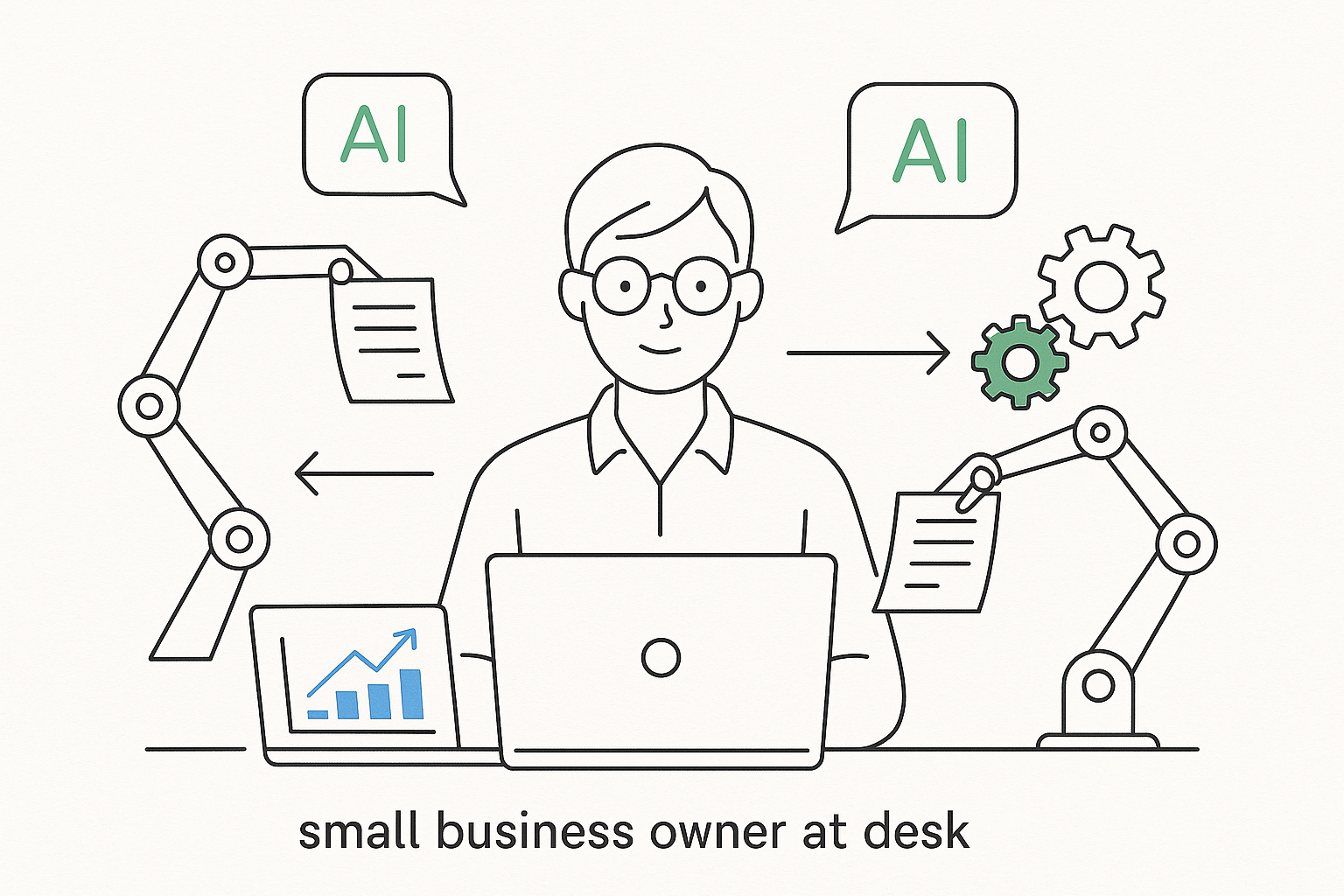
Those late nights spent manually processing invoices, researching competitors, and juggling a dozen different software subscriptions—they’re about to become a distant memory. What started as a healthcare leader’s journey from overwhelm to empowerment has evolved into a comprehensive roadmap for small and medium enterprises ready to harness the most significant business automation breakthrough in decades.
In the era of SME AI automation, the potential for small and medium enterprises to innovate and grow through SME AI automation is greater than ever.
SME AI automation is set to transform how small and medium enterprises operate, bringing unprecedented efficiency and capability to their daily tasks. With the integration of SME AI automation, businesses can streamline operations and improve overall productivity.
As explored in our research on why 91% of Canadian SMEs adopt AI but 92% face major challenges, the gap between AI adoption and successful implementation has been the defining struggle of 2025. OpenAI’s ChatGPT Agent, announced just days ago, fundamentally changes this equation.
SME AI automation enables businesses to optimize their workflow and achieve their goals more effectively.
Moreover, the role of SME AI automation in driving efficiency cannot be overstated.
With SME AI automation, the possibilities for growth and success multiply.
Every organization should embrace SME AI automation to enhance their capability and market position.
As SMEs look to the future, embracing SME AI automation will be crucial for staying competitive.
This new era of SME AI automation sets the stage for unprecedented advancements.
OpenAI’s ChatGPT Agent: The Game-Changer That Changes Everything
On July 17, 2025, OpenAI quietly revolutionized business automation with an announcement that most SME owners are still trying to comprehend. ChatGPT Agent isn’t just another chatbot—it’s a virtual employee that uses its own computer to complete complex, multi-step tasks from start to finish.
Breaking: What ChatGPT Agent Can Do for Your SME:
- Analyze your calendar and brief you on upcoming client meetings using recent industry news
- Plan complete business trips including flights, hotels, and ground transportation
- Create comprehensive competitor analysis reports with professional slide decks
- Handle expense report processing and spreadsheet updates
- Automate social media content creation and scheduling
- Process customer research and compile actionable business insights
According to The Verge’s comprehensive analysis, the model behind ChatGPT Agent was specifically trained on complex business tasks using reinforcement learning, the same technique powering OpenAI’s most advanced reasoning models. For SMEs, this represents the democratization of capabilities previously exclusive to enterprise-level operations and is a key aspect of SME AI automation.
By utilizing SME AI automation, companies can achieve remarkable transformations.
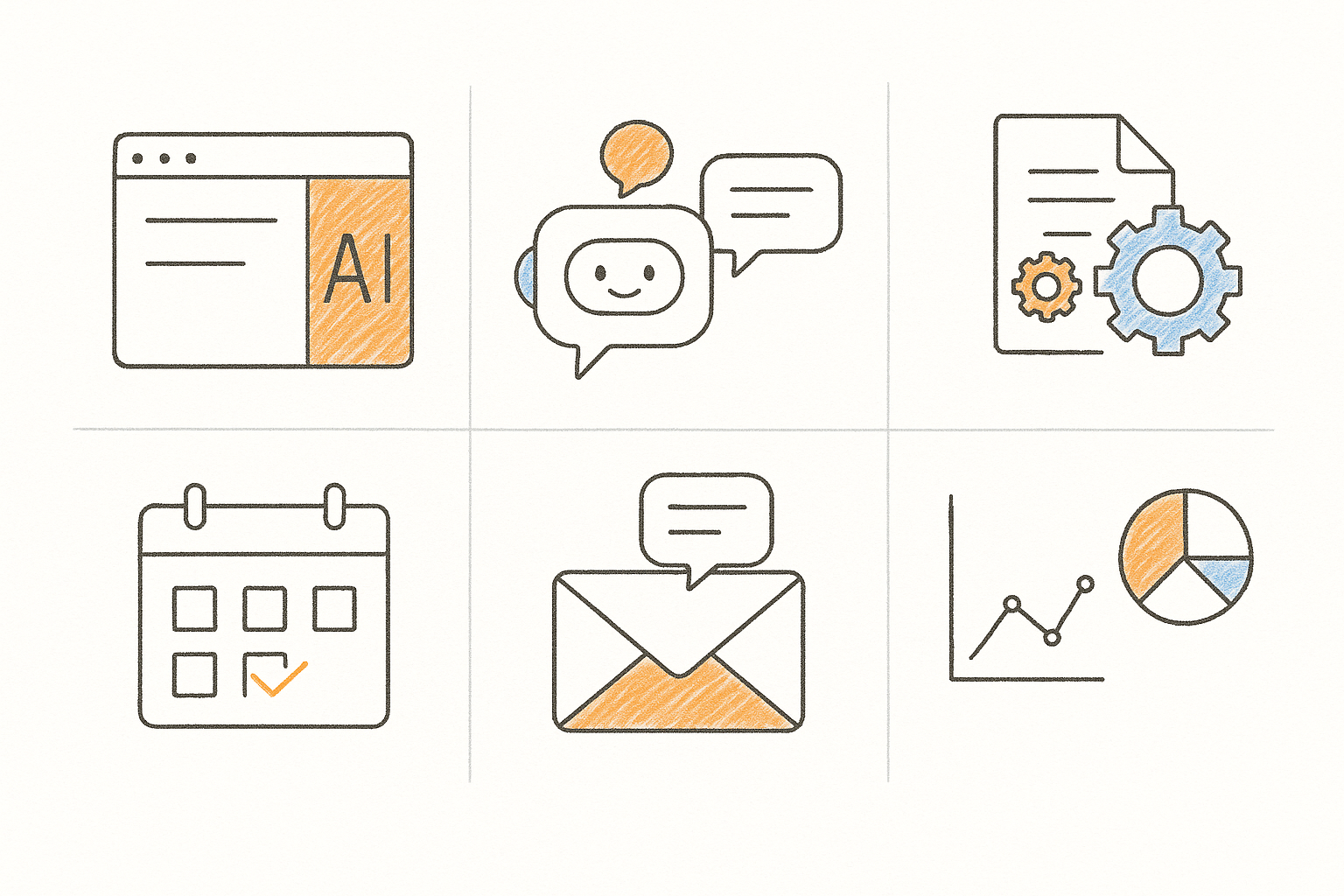
The Technical Breakthrough That Matters for Business
ChatGPT Agent operates using what OpenAI calls a “unified agentic system” that combines three revolutionary capabilities: the web interaction abilities of Operator, the research depth of Deep Research, and the conversational intelligence of ChatGPT. Most importantly for SMEs, it uses its own virtual computer, seamlessly switching between reasoning and action to handle complete workflows.
The agent comes equipped with a comprehensive toolkit including a visual browser for website interaction, a text-based browser for research tasks, terminal access for data processing, and direct API connections to business applications. As detailed in our analysis of practical AI implementation for Canadian SMEs, this represents the end of the fragmented tool approach that has frustrated so many business owners.
Real SME Use Cases: From Chaos to Control
Consider Sarah, who runs a 12-person marketing consultancy in Toronto. Before ChatGPT Agent, her weekly routine involved manually checking five different calendars, researching client industries across dozens of websites, and spending Sunday evenings creating Monday morning briefings for her team. Now, she simply tells ChatGPT Agent: “Brief me on this week’s client meetings and include relevant industry developments.”
With SME AI automation, businesses can respond to changing market conditions swiftly and efficiently.
As we delve deeper into the benefits of SME AI automation, small and medium enterprises will uncover new growth opportunities.
The agent accesses her calendar through connected APIs, researches recent developments in each client’s industry, cross-references this information with her meeting agendas, and delivers a comprehensive briefing document—complete with talking points and follow-up action items. What previously consumed 4-5 hours of her weekend now happens automatically while she sleeps.
Leveraging SME AI automation allows businesses to adapt swiftly to changing market demands.
“Even if it takes 15 minutes, half an hour, it’s quite a big speed-up compared to how long it would take you to do it. It’s one of those things where you can kick something off in the background and then come back to it.” – Isa Fulford, Research Lead, ChatGPT Agent
The future of business will heavily rely on the effective use of SME AI automation.
Ultimately, adopting SME AI automation is essential for long-term success and sustainability.
Organizations that embrace SME AI automation will pave the way for their own success.
The Complete July 2025 AI Automation Arsenal
Many SMEs will leverage SME AI automation to streamline their operations and enhance productivity.
Implementing SME AI automation can lead to groundbreaking outcomes in various industries.
SME AI automation is essential for optimizing operational workflows and enhancing performance.
The integration of SME AI automation will define the next wave of business innovation.
While OpenAI’s ChatGPT Agent dominates the headlines, July 2025 brought a constellation of complementary tools that, when combined strategically, create an automation ecosystem capable of transforming SME operations. As highlighted in our research on why 77% of workers report AI tools make them slower, the key is selecting tools that integrate seamlessly rather than create additional complexity.
In this dynamic landscape, SME AI automation will be a key differentiator for success.
The integration of SME AI automation not only enhances operational efficiency but also boosts employee morale through reduced workloads.
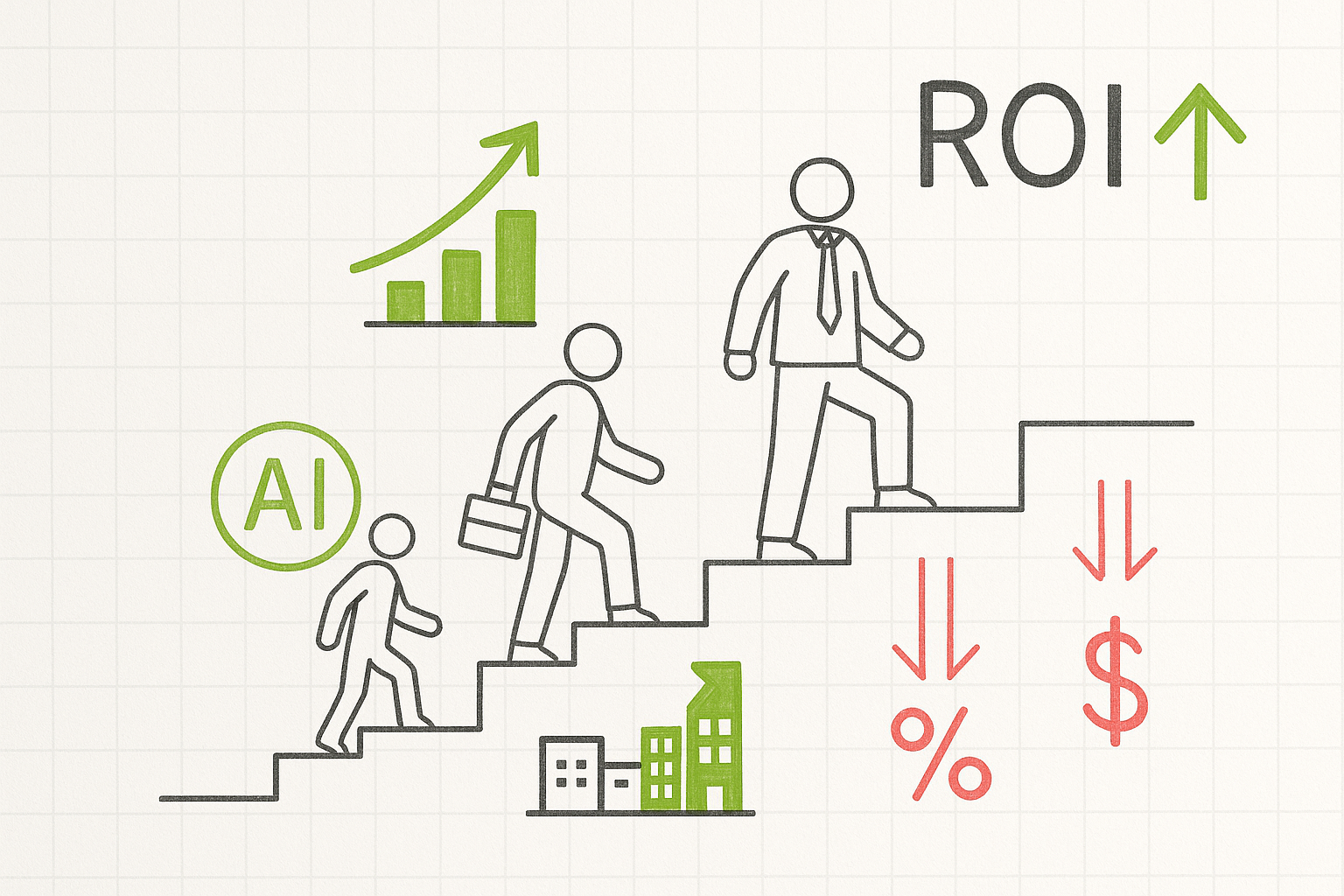
Tool #2: Perplexity’s Comet Browser – The Research Revolution
Launched simultaneously with OpenAI’s announcement, Perplexity’s Comet browser brings AI automation directly into web browsing through an intelligent sidebar. For SMEs drowning in competitive research and market analysis, Comet represents a paradigm shift from manual information gathering to automated intelligence collection.
Comet’s AI automation sidebar can comparison-shop automatically across multiple vendors, analyzing not just price but shipping speed, return policies, and customer reviews. For procurement-heavy SMEs, early adopters report 50% reduction in vendor research time and 25% improvement in purchasing decisions through more comprehensive analysis.
Comet Browser ROI for SMEs:
- Cost: $27 CAD/month (Perplexity Max subscription)
- Time savings: 3-4 hours weekly on research tasks
- Improved decision quality: 25% better vendor selections
- Competitive intelligence: Real-time market monitoring
- Payback period: 2-3 weeks for most SMEs
Tool #3: xAI’s Grok 4 – Real-Time Business Intelligence
Elon Musk’s xAI released Grok 4 in July 2025 with capabilities that specifically address SME pain points around timely market intelligence. Unlike ChatGPT, which requires add-ons for real-time information, Grok 4 includes native web search and tool usage, making it ideal for businesses needing current market data, competitive analysis, and trend monitoring.
For SMEs operating in fast-moving markets, Grok 4’s ability to query live information and run code for analysis provides enterprise-level market intelligence at startup prices. The SuperGrok subscription includes advanced reasoning capabilities that consistently outperform other models on complex business scenario analysis.
Tool #4: Google’s Pixel AI Features – Mobile Business Command Center
Google’s July 2025 Pixel Feature Drop transformed smartphones into powerful business automation hubs. The integration of AI video generation, enhanced Circle-to-Search with cited sources, and Gemini assistant on smartwatches creates a mobile-first business management system particularly valuable for SMEs whose leadership teams are constantly on the move.
The AI Mode for Circle-to-Search allows business owners to photograph competitor pricing, product specifications, or marketing materials and immediately receive detailed analysis with cited sources. For retail SMEs, this creates instant competitive intelligence capabilities previously requiring dedicated market research staff.
Organizations must prioritize SME AI automation to remain competitive and effective.
Tool #5: Zoom’s Enhanced AI Companion – Meeting Automation Excellence
Zoom’s July 2025 update introduced agentic AI capabilities that transform meeting management from time sink to competitive advantage. The Custom AI Companion integrates with over 16 business applications, allowing natural language commands during meetings to pull Salesforce data, post Slack summaries, or retrieve Google Drive files without switching platforms.
At $12 per user monthly, Zoom’s AI Companion eliminates the need for multiple meeting automation subscriptions while providing capabilities that scale with business growth. SMEs report 40% reduction in post-meeting administrative tasks and 60% improvement in follow-up completion rates.
The $50,000 Question: Quantifying SME Automation ROI
Ultimately, SME AI automation will redefine industry standards and expectations.
The most critical question for resource-conscious SMEs isn’t whether these tools work—it’s whether they deliver measurable returns that justify the investment. Based on analysis of early adopter data and RSM’s 2025 AI survey showing $3.70 return for every dollar invested, the automation ROI for SMEs is not just positive—it’s transformational.
| Tool Category | Monthly Cost (CAD) | Weekly Time Savings | Annual Value Created | ROI Percentage |
|---|---|---|---|---|
| ChatGPT Agent Pro | $27 | 15-20 hours | $39,000-52,000 | 12,000%+ |
| Perplexity Comet | $27 | 3-4 hours | $7,800-10,400 | 2,400%+ |
| Grok 4 SuperGrok | $68 | 2-3 hours | $5,200-7,800 | 650%+ |
| Zoom AI Companion | $136 (10 users) | 8-10 hours | $20,800-26,000 | 1,250%+ |
| Complete Stack | $258 | 28-37 hours | $72,800-96,200 | 2,350%+ |
These calculations assume a conservative $65/hour value for management time saved, though many SME owners value their time significantly higher. The compounding effect occurs because automation doesn’t just save time—it enables business owners to focus on revenue-generating activities that were previously crowded out by operational tasks.
The Hidden Multiplier Effect
Beyond direct time savings, AI automation creates what economists call “productivity spillover effects.” When Sarah’s marketing consultancy automated client briefings, she didn’t just save 4-5 hours weekly—she gained the mental space to develop a new service offering that generated an additional $180,000 in annual revenue.
This aligns with findings from our analysis of 170 million new jobs created by 2030, where AI augmentation enables professionals to take on higher-value responsibilities rather than simply working more efficiently at existing tasks.
Implementation Roadmap: From Overwhelm to Automation Excellence
With SME AI automation, the potential for growth and efficiency is limitless.
Understanding the nuances of SME AI automation will be key for leadership teams.
The difference between SMEs that successfully implement AI automation and those that join the 92% facing implementation challenges lies not in technical sophistication, but in strategic sequencing and realistic expectations. Based on successful implementations across diverse SME sectors, here’s the proven pathway from manual operations to automation excellence.
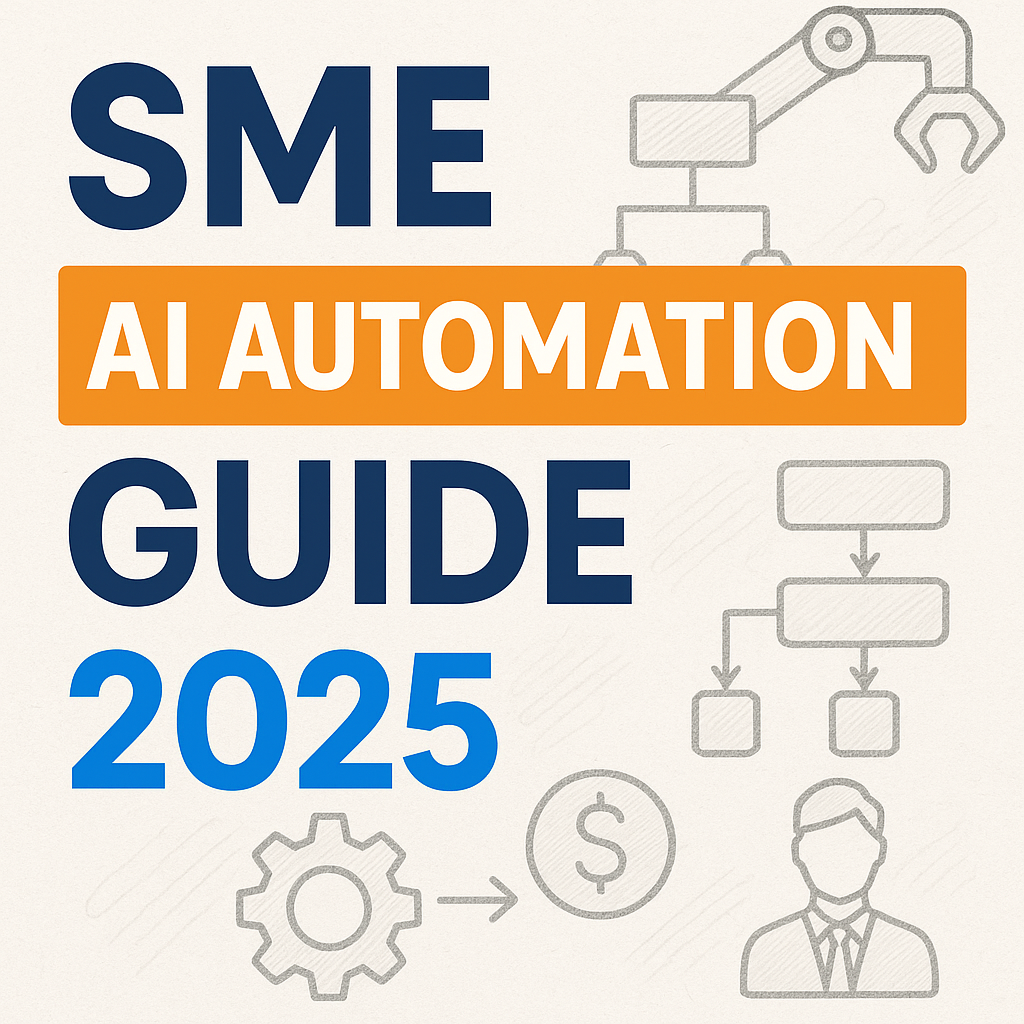
Phase 1: Foundation Assessment (Week 1-2)
Moreover, SME AI automation offers the advantage of data-driven decision-making, propelling SMEs towards success.
Before implementing any AI tools, successful SMEs conduct what we call an “Automation Readiness Assessment”—a systematic evaluation of current processes, data quality, and organizational readiness for change. This assessment, similar to our Women in AI Readiness Assessment, provides the strategic foundation for tool selection and implementation sequencing.
Assessment Framework:
- Process Mapping: Document current workflows and identify automation opportunities
- Data Audit: Evaluate data quality, accessibility, and integration requirements
- Skill Evaluation: Assess team digital literacy and training needs
- Technology Stack Review: Inventory existing tools and integration capabilities
- ROI Modeling: Calculate potential returns and establish success metrics
Phase 2: Strategic Pilot Implementation (Week 3-8)
Rather than attempting comprehensive automation immediately, successful SMEs begin with high-impact, low-complexity pilot projects that demonstrate value while building organizational confidence. The key is selecting pilots that solve real business problems while teaching broader automation principles.
Recommended Pilot Sequence:
Week 3-4: ChatGPT Agent Foundation
Begin with ChatGPT Agent Pro subscription and focus on one core business process—typically competitive research or meeting preparation. The goal is mastering agent-human collaboration patterns that apply across all automation initiatives.
Week 5-6: Research and Intelligence Integration
Add Perplexity Comet browser and establish automated competitive monitoring and market research workflows. This builds data-driven decision-making capabilities while demonstrating automation’s strategic value.
Week 7-8: Communication and Collaboration Enhancement
Implement Zoom AI Companion for meeting automation and begin exploring Grok 4 for real-time business intelligence. Focus on workflow integration rather than tool mastery.
Phase 3: Scaling and Optimization (Week 9-16)
The scaling phase separates successful automation implementations from expensive experiments. This is where strategic foundation and pilot learnings translate into enterprise-wide transformation. According to Microsoft’s research showing 71% of Canadian SMBs use AI, most businesses stall at this stage due to lack of systematic scaling methodology.
Scaling Success Framework:
- Process Standardization: Document successful pilot workflows and create replicable procedures
- Team Training Programs: Develop AI literacy curricula tailored to specific job functions
- Integration Architecture: Build systematic connections between AI tools and existing business systems
- Performance Monitoring: Establish KPIs and feedback loops for continuous optimization
- Change Management: Address resistance and cultural barriers to automation adoption
Competitive Analysis: How AI Automation Reshapes Market Dynamics
The July 2025 AI automation breakthrough creates unprecedented competitive dynamics where traditional advantages like scale, experience, and capital become less decisive than automation sophistication and implementation speed. For SMEs, this represents the greatest leveling opportunity in modern business history.
The New Competitive Landscape
Traditional competitive analysis focused on comparing resources: staff size, marketing budgets, operational capacity, and market presence. AI automation fundamentally alters these equations by enabling small teams to deliver enterprise-level capabilities and responsiveness.
Consider the competitive implications of ChatGPT Agent for professional services SMEs competing against large consulting firms. Previously, large firms won projects partly through their ability to assign multiple analysts to comprehensive research and deck creation. Now, a three-person consultancy with ChatGPT Agent can deliver the same depth of analysis and professional presentation quality in a fraction of the time and cost.
“AI works best when complementing human ingenuity. Companies must upskill their workforce and implement rigorous oversight and AI governance measures to fully capitalize on AI’s potential while mitigating risks.” – Rhys Morgan, Consulting Partner, RSM Canada
SME Competitive Advantages in the AI Era
While large enterprises have resource advantages, SMEs possess structural advantages in AI automation adoption that smart business owners can leverage for competitive superiority:
Implementation Speed: SMEs can implement and iterate on AI automation without enterprise bureaucracy, approval chains, or legacy system constraints. What takes large companies months or years can be accomplished by agile SMEs in weeks.
Customer Intimacy: AI automation frees SME owners and teams to deepen customer relationships and provide personalized service that larger competitors struggle to match at scale.
Innovation Flexibility: SMEs can experiment with cutting-edge AI tools and pivot strategies quickly, while large enterprises must consider broad organizational impact and risk management protocols.
Operational Efficiency: AI automation eliminates many traditional scale advantages, allowing small teams to deliver big company capabilities while maintaining startup agility and cost structure.
Industry-Specific Implementation Strategies
While the core AI automation tools remain consistent across industries, successful implementation requires understanding sector-specific applications, compliance requirements, and competitive dynamics. Here’s how different SME sectors can optimize their automation strategies.
Investing in SME AI automation is a strategic move that businesses cannot afford to ignore.
Professional Services: From Time-Based to Value-Based Pricing
Professional services SMEs—from accounting firms to marketing agencies—face unique automation opportunities and challenges. The traditional billable hour model becomes problematic when AI handles tasks that previously required human time, but this challenge creates opportunities for value-based pricing and service differentiation.
Automation Focus Areas:
- Research and Analysis: ChatGPT Agent can handle comprehensive industry research, competitive analysis, and trend identification, freeing professionals for strategic interpretation and client consultation.
- Document Creation: Automated proposal writing, contract drafting, and report generation using client-specific data and industry templates.
- Client Communication: Intelligent meeting preparation, follow-up automation, and proactive client insight delivery.
- Administrative Tasks: Expense processing, time tracking optimization, and project management automation.
Retail and E-commerce: Customer Experience Automation
Retail SMEs can leverage AI automation to compete with large retailers on customer experience while maintaining local market advantages and personal service quality.
Strategic Applications:
- Inventory Intelligence: Predictive inventory management using Grok 4’s real-time market analysis combined with historical sales data.
- Customer Research: Automated customer preference analysis and product recommendation systems using ChatGPT Agent.
- Marketing Automation: Social media content creation, email campaign optimization, and local market analysis.
- Competitive Monitoring: Real-time pricing analysis and market positioning using Perplexity Comet’s research capabilities.
Manufacturing and Distribution: Operational Excellence
Manufacturing SMEs can use AI automation to optimize operations, improve quality control, and enhance supply chain management without massive capital investments in industrial automation.
Implementation Priorities:
Embracing SME AI automation can lead to transformative growth and enhanced market presence.
The future of SMEs is intertwined with the advancements brought by SME AI automation.
Thus, SME AI automation will play a crucial role in shaping the business landscape ahead.
- Supply Chain Intelligence: Automated vendor research, pricing analysis, and supply risk monitoring using multiple AI tools in combination.
- Quality Documentation: Automated quality control reporting, compliance documentation, and process improvement analysis.
- Customer Service: Technical support automation, order processing, and customer communication management.
- Business Intelligence: Production planning, demand forecasting, and performance analytics using AI-enhanced data analysis.
Risk Management and Safety Considerations
With great automation power comes great responsibility—and real risks that SMEs must understand and mitigate. OpenAI’s implementation of “High Biological and Chemical capabilities” safeguards for ChatGPT Agent signals the increasing importance of responsible AI adoption, even for routine business applications.
Understanding the Risk Landscape
AI automation introduces novel risk categories that traditional business risk management frameworks don’t address. These include prompt injection attacks, where malicious actors attempt to manipulate AI behavior through hidden instructions in web content, and model hallucinations, where AI systems confidently present incorrect information.
For SMEs, the most significant risks are typically operational rather than existential: over-reliance on AI without human oversight, data privacy breaches, and the potential for AI-generated content to damage professional relationships or brand reputation.
SME Risk Mitigation Framework:
- Human-in-the-Loop Protocols: Maintain human review for all customer-facing and financially significant AI outputs
- Data Privacy Controls: Use business-tier subscriptions, avoid uploading sensitive data, and regularly audit AI tool permissions
- Quality Assurance Systems: Establish validation procedures for AI-generated analysis and recommendations
- Incident Response Planning: Prepare procedures for AI tool failures, data breaches, or quality issues
- Continuous Monitoring: Regular assessment of AI tool performance, accuracy, and alignment with business objectives
Building Responsible AI Practices
Successful SMEs treat AI automation as a partnership rather than replacement, maintaining the human judgment and ethical oversight that no algorithm can provide. This approach not only reduces risks but often leads to better business outcomes through the combination of AI efficiency and human wisdom.
The Path Forward: Your Next Steps
The AI automation revolution is not coming—it arrived on July 17, 2025, with OpenAI’s ChatGPT Agent announcement. For SMEs, the question isn’t whether to adopt these tools, but how quickly you can implement them strategically while your competitors struggle with the complexity.
The data is overwhelming: $3.70 return for every dollar invested in AI, potential annual savings of $50,000-$100,000 for typical SMEs, and the opportunity to compete with enterprise-level capabilities at startup costs.
Immediate Action Items (This Week)
- Subscribe to ChatGPT Pro ($20/month) and begin experimenting with agent mode for one core business process
- Conduct an automation readiness assessment using the framework provided in this guide
- Identify your highest-impact pilot project based on time-consuming, repetitive tasks with clear success metrics
- Document current workflows for the processes you plan to automate first
- Calculate your specific ROI potential using the formulas and examples provided
30-Day Implementation Goals
- Master ChatGPT Agent for your pilot process and document time savings and quality improvements
- Add complementary tools (Perplexity Comet, Zoom AI Companion) based on your specific business needs
- Train key team members on AI collaboration best practices and safety protocols
- Establish measurement systems for tracking automation ROI and business impact
- Plan scaling strategy for expanding automation to additional business processes
90-Day Transformation Target
- Achieve measurable ROI from initial automation investments with documented time and cost savings
- Scale successful pilots to additional business areas and team members
- Develop competitive advantages through AI-enhanced capabilities your competitors lack
- Build organizational AI literacy through training programs and best practice documentation
- Position for advanced automation by establishing the foundation for more sophisticated AI integration
Conclusion: The Future Belongs to the Prepared
The convergence of OpenAI’s ChatGPT Agent with complementary automation tools from Perplexity, xAI, Google, and Zoom creates an unprecedented opportunity for SMEs to leapfrog traditional competitive disadvantages. For the first time in business history, a small team with the right automation strategy can deliver enterprise-level capabilities while maintaining the agility and customer focus that are SME advantages.
The SMEs that thrive in this new landscape won’t be those with the largest budgets or most technical expertise—they’ll be the ones who recognize this inflection point and act decisively while their competitors hesitate. The tools are available, the ROI is proven, and the competitive window is opening.
As we’ve seen throughout our analysis of AI implementation challenges and practical solutions for Canadian SMEs, success in AI automation isn’t about perfection—it’s about progress. Start small, learn fast, and scale strategically.
The $50,000 question isn’t whether AI automation will transform your business—it’s whether you’ll lead that transformation or be forced to catch up later. The choice, and the tools, are now in your hands.
“The future belongs to those who can harness AI’s power while preserving the human skills that no algorithm can replace. For SMEs, this means becoming AI-augmented businesses that combine technological efficiency with human judgment, creativity, and relationship-building capabilities.”
Ready to begin your automation transformation? The journey from overwhelm to empowerment starts with a single step—and that step is available to you right now.
Frequently Asked Questions
Q: How quickly can a typical SME expect to see ROI from AI automation tools?
A: Based on early adopter data, most SMEs see positive ROI within 30-60 days. Time savings are immediate (first week), efficiency gains compound over the first month, and cost reductions become apparent by month two. ChatGPT Agent users report saving 15-20 hours weekly within the first month of implementation.
Q: What’s the total monthly cost for implementing all recommended AI automation tools?
A: For a 10-person SME, the complete automation stack costs approximately $258 CAD monthly: ChatGPT Pro ($27), Perplexity Comet ($27), Grok 4 SuperGrok ($68), and Zoom AI Companion ($136 for 10 users). This investment typically saves $6,000-8,000 monthly in labor costs and productivity gains.
Q: Are these AI tools safe for handling sensitive business information?
A: OpenAI has implemented their strongest safety protocols for ChatGPT Agent, including “High Biological and Chemical capabilities” safeguards. However, SMEs should use business-tier subscriptions, avoid uploading extremely sensitive data until enterprise features roll out, and maintain human oversight for critical decisions. All major tools offer SOC 2 compliance and encrypted data transmission.
Q: How does AI automation help SMEs compete with larger companies?
A: AI automation democratizes capabilities previously exclusive to large enterprises. SMEs can now access enterprise-level research, analysis, and automation at consumer prices, while maintaining advantages in implementation speed, customer intimacy, and innovation flexibility. A small team with ChatGPT Agent can deliver analysis and presentations comparable to large consulting firms.
Q: What if my team isn’t technically sophisticated enough for AI implementation?
A: Modern AI tools are designed for non-technical users. ChatGPT Agent, Perplexity Comet, and similar tools use natural language interfaces that require no coding or technical expertise. The key is starting with simple use cases, providing basic training, and gradually expanding capabilities as team confidence grows.
Q: Should SMEs wait for more mature AI tools or implement current solutions now?
A: The competitive advantage goes to early adopters who implement current tools strategically. While AI will continue evolving, the July 2025 releases represent mature, business-ready solutions with proven ROI. Waiting allows competitors to gain automation advantages that become harder to overcome as they optimize their systems and processes.
References and Sources
1. OpenAI. (2025, July 17). Introducing ChatGPT agent: bridging research and action. https://openai.com/index/introducing-chatgpt-agent/
2. Nilay, P. & Fulford, I. (2025, July 18). OpenAI’s new ChatGPT Agent can control an entire computer and do tasks for you. The Verge. https://www.theverge.com/ai-artificial-intelligence/709158/openai-new-release-chatgpt-agent-operator-deep-research
3. Perplexity AI. (2025, July). Introducing Comet. https://www.perplexity.ai/hub/blog/introducing-comet
As we move forward, SME AI automation will become even more integral to operational strategy.
4. xAI. (2025, July). Grok 4 Release Notes. https://x.ai/news/grok-4
5. Microsoft Canada. (2025, June 25). Majority of Canadian Small and Medium-Sized Businesses Embrace AI. https://news.microsoft.com/source/canada/2025/06/25/majority-of-canadian-small-and-medium-sized-businesses-embrace-ai-with-71-actively-using-tools-to-drive-efficiency-and-growth/
6. RSM Canada. (2025). 2025 RSM Middle Market AI Survey. https://canadiansme.ca/middle-market-firms-rapidly-embracing-generative-ai-but-expertise-gaps-pose-risks-rsm-2025-ai-survey/
7. Chager, J. (2025). The AI Implementation Paradox: Why 91% of Canadian SMEs Adopt AI but 92% Face Major Challenge. https://chager.org/the-ai-implementation-paradox-why-91-of-canadian-smes-adopt-ai-but-92-face-major-challenge/
8. Chager, J. (2025). Beyond the Hype: Practical AI for Canadian SMEs in 2025. https://chager.org/beyond-the-hype-practical-ai-for-canadian-smes-in-2025-unlocking-real-growth-and-government-support/
As companies adapt to the digital landscape, the role of SME AI automation becomes increasingly significant.
Investing in SME AI automation is no longer an option; it’s a necessity for growth and sustainability.
Success in today’s market will increasingly depend on the effective utilization of SME AI automation.
In conclusion, SME AI automation empowers businesses to thrive in competitive markets while enhancing overall productivity.
By embracing SME AI automation, businesses can turn challenges into opportunities.
In summary, SME AI automation is key to achieving operational excellence and strategic advantage.
Finally, the integration of SME AI automation is essential for navigating future market dynamics.
Adopting SME AI automation is a strategic imperative for any forward-thinking organization.
In conclusion, SME AI automation empowers businesses to thrive in competitive markets while enhancing overall productivity.
🚀 Get Your Personalized AI Tool Stack
Don’t guess which of these 7 AI tools your business actually needs. Take our smart quiz and get a custom automation blueprint designed for YOUR specific business requirements.
✅ Personalized tool recommendations
✅ Exact ROI projections for your business
✅ 30-60-90 day implementation roadmap

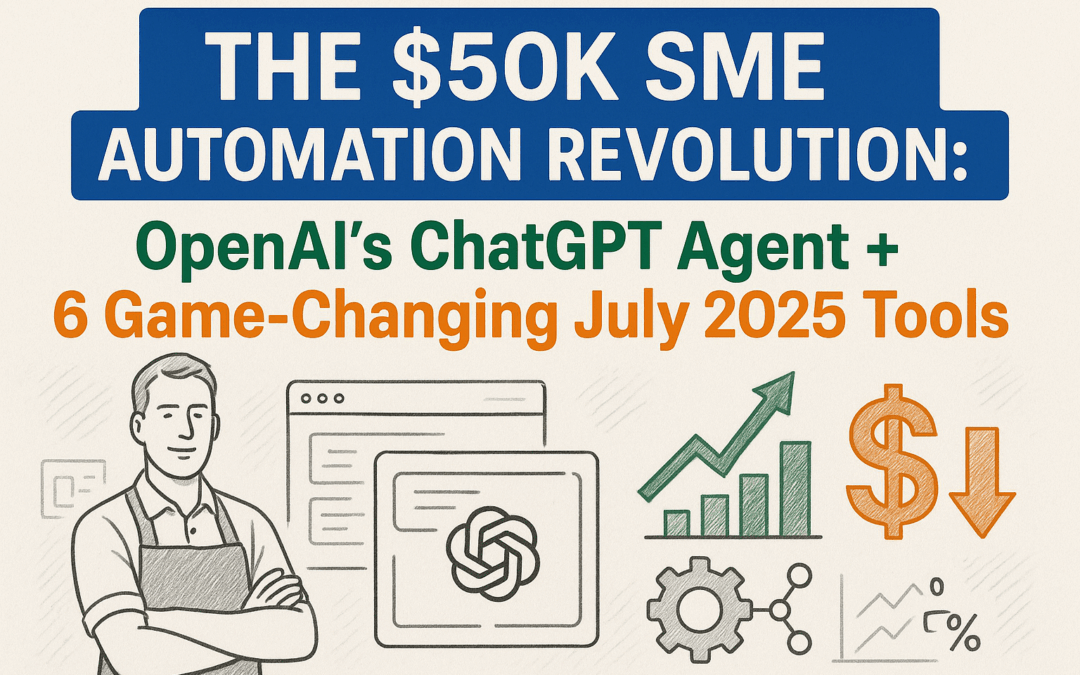

Recent Comments